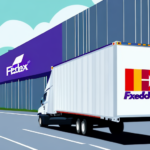Understanding Standard Shipping Rates for FedEx
FedEx, a leading shipping and logistics company, offers a comprehensive range of services for transporting packages and freight both domestically and internationally. The cost of shipping with FedEx varies based on several factors, including package size, weight, delivery speed, and destination. In this article, we'll delve into the different components that influence FedEx shipping rates and provide actionable tips on how to save money and enhance efficiency when utilizing their services.
How to Determine Shipping Rates for Your Packages
The first step in understanding FedEx shipping rates is to comprehend their pricing model. FedEx calculates shipping costs based on the distance between the origin and destination, the weight and dimensions of the package, and the selected delivery speed. Additionally, there may be extra fees and surcharges depending on the specifics of your shipment and destination.
One crucial factor to consider is the type of package you are sending. FedEx offers different rates for envelopes, packages, and freight shipments:
- Envelopes: Most affordable for small, lightweight items.
- Packages: Suitable for standard-sized items.
- Freight Shipments: Ideal for large, heavy items requiring specialized handling.
Another important consideration is the shipping destination. FedEx provides distinct rates for domestic and international shipments, with variations depending on the specific country or region. It's essential to research and compare rates for different destinations to ensure you secure the best possible deal.
Factors That Affect FedEx Shipping Rates
Several factors can impact your FedEx shipping rates. Key factors include:
- Distance: Longer shipping distances typically result in higher costs.
- Package Weight: Heavier packages incur higher shipping fees.
- Package Dimensions: Larger packages require more space and may cost more.
- Delivery Speed: Faster delivery options, such as overnight or two-day shipping, come at a premium cost.
Additional factors can include the type of items shipped (e.g., fragile or hazardous materials may require special handling), the destination's accessibility, and the time of year. For instance, during peak holiday seasons, shipping rates may increase due to higher demand.
For more detailed insights, refer to FedEx's official shipping rates page.
How to Calculate Shipping Costs for Different Package Sizes and Weights
Calculating shipping costs for FedEx packages involves understanding both the weight and dimensions of your shipment. Utilize FedEx's online shipping calculator to obtain accurate rate estimates based on your package specifications. For larger or bulk shipments, you can request a rate sheet from your FedEx account representative.
Consider the destination of your package as well. Shipping to residential addresses may incur higher fees compared to commercial addresses. Additionally, international shipments might require extra documentation and fees such as customs duties and taxes.
Optimizing your packaging materials can also impact shipping costs. Using appropriately sized and lightweight packaging helps minimize both weight and dimensional factors, leading to lower shipping fees. Avoid oversized boxes and excessive packing materials that can increase the overall cost.
Understanding the Differences Between FedEx Ground, Express, and Freight Services
FedEx offers a variety of shipping services tailored to different needs:
- FedEx Ground: The most cost-effective option for standard deliveries, typically used for domestic shipments.
- FedEx Express: Provides faster delivery times, ideal for urgent shipments, but at a higher cost.
- FedEx Freight: Designed for larger or heavier items that require specialized handling and transportation.
When choosing between these services, consider factors such as tracking and insurance options, delivery speed, and additional features like signature confirmation or inside delivery. For example, FedEx Ground typically offers more economical rates with standard tracking, whereas FedEx Express includes enhanced tracking and expedited delivery.
For a comprehensive comparison, visit FedEx's official services page.
Strategies to Save Money on FedEx Shipping Costs
Implementing effective strategies can help reduce your FedEx shipping expenses:
- Bundle Shipments: Consolidate multiple shipments into a single larger shipment to decrease the cost per item.
- Select Slower Shipping Speeds: Opting for standard delivery times can significantly lower costs without compromising essential delivery schedules.
- Partner with Third-Party Logistics Providers: These providers can negotiate better rates with FedEx and optimize your shipping operations for increased efficiency.
Additionally, taking advantage of FedEx discounts and promotions can lead to substantial savings. These offers may be available for specific shipment types, such as international or high-volume shipments, and are often promoted during peak seasons like holidays.
How to Qualify for Discounts and Special Offers from FedEx
FedEx provides a variety of discounts and special offers to support its customers:
- Volume-Based Discounts: Lower rates for shipping higher volumes.
- Promotional Offers: Seasonal or limited-time discounts available during peak periods.
- Loyalty Rewards: Benefits for long-term customers who frequently utilize FedEx services.
To qualify for these discounts, consider enrolling in FedEx Advantage, their loyalty program, which offers exclusive rates and rewards for frequent shippers. Additionally, the FedEx referral program allows you to earn discounts by referring new customers to their services.
For more information, contact your FedEx account representative or visit the FedEx Account Services page.
Tips for Choosing the Right Packaging Materials to Minimize Shipping Costs
Selecting the appropriate packaging materials is crucial for reducing shipping expenses:
- Use Lightweight Materials: Opt for padded envelopes or bubble wrap instead of heavy boxes to decrease package weight.
- Optimize Package Size: Ensure the package is tightly packed to minimize unused space, which can lead to lower dimensional weight charges.
- Protect Fragile Items: Utilize materials like foam inserts or air pillows to safeguard delicate items without adding excessive weight.
- Choose Sustainable Options: Eco-friendly packaging materials, such as recyclable or biodegradable options, can also contribute to cost savings and environmental responsibility.
Proper packaging not only reduces costs but also minimizes the risk of damage during transit, ensuring a better experience for your customers.
How to Track Your FedEx Shipments and Delivery Status
FedEx offers multiple methods to monitor your shipments and track delivery status:
- Online Tracking: Use the FedEx website to enter your tracking number and view real-time status updates.
- FedEx Mobile App: Access tracking information on the go with the FedEx mobile application.
- Delivery Notifications: Sign up for alerts via email or SMS to receive updates throughout the shipping process.
- Advanced Tracking Features: Options such as in-home delivery, weekend delivery, and package hold at a nearby location provide added convenience and flexibility.
For comprehensive tracking, visit the FedEx Tracking page.
Common Mistakes That Can Increase Your FedEx Shipping Rates
Avoid these common mistakes to prevent unnecessary increases in your FedEx shipping costs:
- Incorrect Package Measurements: Ensure accurate measurement of package dimensions to avoid dimensional weight surcharges.
- Poor Packaging: Improperly packaged items may require re-packaging or incur additional handling fees.
- Choosing an Inappropriate Delivery Speed: Selecting a faster delivery option than necessary can lead to higher costs.
- Missed Pickups or Delivery Attempts: These can result in extra fees and delays.
By meticulously preparing your shipments and selecting the appropriate services, you can minimize additional costs and ensure a smooth shipping experience.
How to Avoid Hidden Fees and Surcharges on Your FedEx Invoices
FedEx invoices may include various additional fees and surcharges that can inflate your shipping costs:
- Fuel Surcharges: Variable fees based on fluctuating fuel prices.
- Residential Delivery Fees: Additional charges for delivery to residential addresses.
- Handling Fees: Applied to oversized or irregularly shaped packages.
To avoid unexpected charges:
- Review each invoice carefully to identify all applied fees.
- Communicate regularly with your FedEx account representative to understand potential surcharges.
- Ensure your shipments are correctly packaged and labeled to prevent unnecessary handling fees.
For a detailed breakdown of FedEx fees, refer to the FedEx Rates page.
How to Compare FedEx Shipping Rates with Other Carriers and Services
When comparing shipping carriers, consider the following factors:
- Shipping Rates: Compare costs based on your specific package size, weight, delivery speed, and destination.
- Additional Services: Look at package tracking, delivery notifications, and insurance options offered by each carrier.
- Reputation and Customer Service: Assess the reliability and customer support quality of each carrier to ensure your packages are handled with care.
Tools like shipping rate comparison websites can aid in evaluating and selecting the best carrier for your needs.
The Benefits of Using a Third-Party Logistics Provider for Your Shipping Needs
Partnering with a third-party logistics (3PL) provider can offer numerous advantages:
- Cost Savings: 3PLs often secure better shipping rates through bulk discounts and partnerships.
- Improved Efficiency: Streamlined shipping operations and reduced handling times.
- Access to Additional Services: Services such as warehousing, inventory management, and international shipping support.
By outsourcing logistics to a 3PL, businesses can focus on their core competencies while ensuring their shipping needs are met efficiently and cost-effectively.
Learn more about the benefits of 3PLs on the ShipScience 3PL Guide.
How Technology Is Changing the Way We Ship Packages with FedEx
Technological advancements are revolutionizing the shipping industry, including services offered by FedEx:
- Real-Time Package Tracking: Enhanced visibility into shipment status and locational data.
- Automated Labeling and Invoicing: Streamlined processes reduce manual errors and save time.
- Autonomous Vehicles and Drones: Emerging technologies promise faster and more efficient deliveries.
- AI and Machine Learning: Improved logistics planning and predictive analytics for better demand forecasting.
These innovations not only enhance operational efficiency but also improve the overall customer experience by providing faster, more reliable delivery options.
For more information on FedEx's technological initiatives, visit the FedEx Technology page.
Best Practices for Managing Your Shipping Operations with FedEx
Effective management of your shipping operations with FedEx involves several best practices:
- Proper Packaging and Labeling: Ensure all packages are securely packed and accurately labeled to prevent delays and additional fees.
- Effective Communication: Maintain clear communication with both customers and FedEx representatives to address any issues promptly.
- Regular Invoice Reviews: Monitor your shipping invoices and fees for accuracy and cost-effectiveness.
- Continuous Optimization: Regularly assess and refine your shipping processes to improve efficiency and reduce costs.
By implementing these best practices, businesses can enhance their shipping operations, reduce costs, and provide excellent service to their customers.
For a detailed guide on managing shipping operations, refer to the Shipping Operations Best Practices.
By understanding the factors that determine FedEx shipping rates and applying strategies to optimize your shipping processes, businesses can effectively manage their shipping operations and deliver exceptional service to their customers.




















